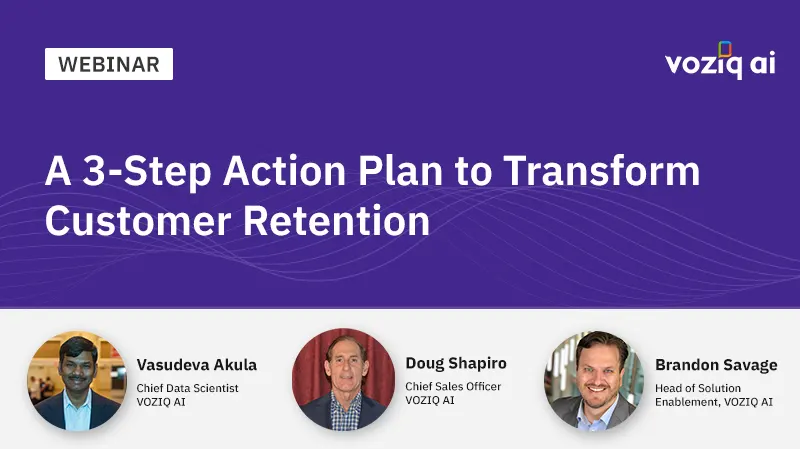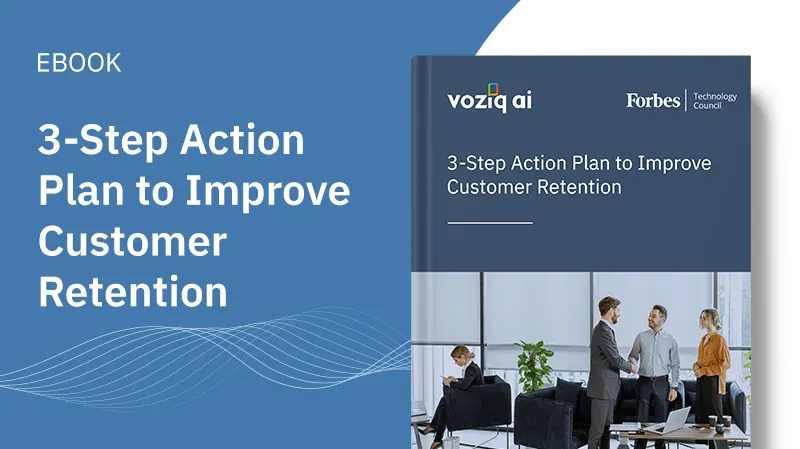100 Interesting Stats and Predictions for Customer Retention Leaders

100 Interesting Stats and Predictions for Customer Retention Leaders
With the growing competition among businesses in today’s market, the chances of distinguishing your business from your competition is diminishing considerably. But one thing is obvious! Every business will try to enhance customer experience, reduce service costs, retain customers, and escalate revenue growth.
To understand what your business must be focusing on, look at some of these stats and few predictions about customer retention to recognize what they mean for your organizations future.
Customer Experience:
- Each of the industry leaders has, on average, 41% of its customers rank experiences as very poor or poor.
- 75% of people now expect a consistent experience wherever they engage with brands, be it through social media, mobile, or even in person.
- 86% of those who received a great customer experience were likely to repurchase from the same company.
- Only 11% of large companies have strong CX metrics programs.
- 65 % of companies are good at collecting and calculating metrics, but less than 20% are good at using analytics to predict future changes in the CX metric.
- More than half (52%) of consumers are likely to switch brands if a company doesn’t make an effort to personalize communications to them as an individual.
- Only 50% of CX pros have modeled how overall CX quality influences customer behavior.
- Customers who had excellent experiences were 30% less likely to cut the cord than customers who had poor experiences. (TV service providers stand to gain on both ends of the spectrum).
- By 2020, it’s estimated 40% of all analytical projects will cover at least one aspect of customer experience.
- Only 10% of companies always or almost always make explicit trade-offs between CX metrics and financial results.
- 82% of U.S. consumers stopped doing business with a company due to a poor customer experience.
- 76% of consumers expect companies to understand their needs and expectations.
- Customers are 2.1x more likely to view personalized offers as important versus unimportant.
- 59% of customers say tailored engagement based on past interactions is very important to winning their business.
- 70% of customers say understanding how they use products and services is very important to winning their business.
- 73% of companies with above average CX maturity have better financial performance than their competitors, compared with 44% of less mature companies.
- After a bad customer experience with a company, 22% of consumer’s decreased their spending and 19% completely stopped doing business with the company.
- When consumers have a very good CX, they are 3.5X more likely to make additional purchase than if they have a very poor CX.
- 8% of large companies view themselves as CX leaders in their industry, and 55% have goals to be an industry leader within three years.
- After a bad experience, 30% of consumers tell the company, 50 % tell their friends, 15% provide feedback on a ratings site, and 14% tweeted about it.
- When consumers have a very good CX, they are 5X more likely to recommend than if they have poor CX.
- 68% of large companies cite “other competing priorities” as a significant obstacle to their CX efforts. It’s the top obstacle for the sixth straight year.
- 89% of companies now expect to compete mostly on the basis of customer experience.
Customer Service:
- 68% of service teams agree that one bad service experience can inflict more damage on a customer relationship than it would have five years ago.
- 73% of consumers and 78% of business buyers are likely to switch brands if they receive inconsistent levels of service.
- More than two-thirds of service teams (67%) proactively provide sales with intelligence on customer issues and needs.
- 81% of service teams say service has the largest impact on how customers perceive their brand.
- 65% of service teams agree that customers broadcast positive experiences more publicly than they did five years ago.
- Only 37% of service teams excel at gathering insights across the entire customer lifecycle (i.e., data and reporting across support, sales, and marketing transactions).
- 69% of service teams empower agents to go off script to create a better customer experience.
- 71% of overall service professionals use coaching and training tools to enhance their teams.
- 90% of high-performing teams say they have the right amount of training to do their job better (versus 48% of underperformers).
- 80% of service teams agree that a shared, single view of the customer empowers departments to provide a more consistent experience across every channel.
- 85% of top service teams excel at having a shared, single view of the customer — 3.5x more so than underperformers (25%).
- Two-thirds (66%) of service teams have become more focused on providing customers with real-time responses and feedback.
- 64% of consumers and 80% of business buyers today expect companies to react to them in real-time.
- Nearly two-thirds (65%) of service teams have shifted their strategic vision to be more focused on increasing agent productivity over the past 12–18 months.
- 61% of service teams are putting more focus toward understanding customers’ full service history, 68% are focused on providing a consistent experience across every channel.
- 79% of service teams prioritize customers’ needs over hitting their performance metrics.
- 42% of customers would stop using a brand if the company didn’t have a real-time customer support line.
- A customer is four times more likely to buy from a competitor if the problem is service-related, versus price or product-related.
- 77% of top service teams excel at leveraging artificial intelligence (AI) compared to 36% of underperformers.
- 71% of service professionals agree they have implemented more customer-oriented KPIs to measure performance.
- 68% of leaders are turning customer service from a cost center into a growth engine.
- 77% of service professionals were more focused over the past 12–18 months on creating deeper customer relationships.
- 76% of service professionals were more focused over the past 12–18 months on providing customers with a consistent experience across every channel.
- 73% of service professionals agree Service and sales share common goals and metrics.
- 71% of service professionals agree service has insight into interactions, sales has with customers.
- 73% of service professionals agree marketing and service are empowered to collaborate.
- 71% of service professionals are using service analytics to deliver proactive Service.
- 58% of service professionals are using predictive intelligence to deliver proactive service.
- 44% of service professionals are using predictive dialing to deliver proactive service.
- 93% of service teams use phone service channel to better serve customers.
- B2C marketing decision makers indicate that 37% of their marketing program budget is spent on new customer acquisition (both predetermined and unnamed prospects) whereas only 20% of marketing budget is spent on driving retention/upsell to existing customers.
- 62% of online adults agree with the statement, “I would like to be able to move between customer service channels and not have to repeat my situation every time.”
- Over the past two years, 89% of service teams have increased or maintained their budgets (61% increased; 28% maintained).
- 68% of service teams agree they’re leading customer experience initiatives across the business.
- “Everyone is in customer service,” with 78% of service teams saying they view every employee as an agent of customer service.
- 63% of service teams have a formal process in place to collaborate with sales.
- 66% of service teams say field service agents partner/collaborate with other agents.
- 68% of service teams say field service agents are an integral part of their customer experience strategy.
- 76% of field service agents interact/schedule directly with customers rather than through an intermediary.
- Overall, 70% of service teams say their strategic vision over the past 12–18 months has become more focused on creating deeper customer relationships.
- In order to build rapport with customers, 67% of high-performing teams use real-time conversational intelligence.
- 52% of consumers have switched providers in the past year due to poor customer service.
- In the United States, the estimated cost of customers switching due to poor service is $1.6 trillion.
- 84% of customers say being treated like a person, not a number, is very important to winning their business.
- 63% of customers expect companies to provide new products/services more frequently than ever before.
- Customers are 9.5x more likely to view AI as revolutionary versus insignificant.
- 63% of large companies are good at soliciting customer feedback, but only 24% are good at taking action based on the insights.
- 80% of executives with service oversight (e.g., CEOs, service VPs, etc.) say customer service is the primary vehicle for improving the customer experience.
- 50% of customers allow a company one week to respond to an inquiry before abandoning the service.
- 73% of customers commit to a brand because of strong customer service.
Customer Loyalty:
- 91% of unsatisfied customers will not return for a repeat purchase or service.
- 33% of younger customers are willing to wait only 1 to 3 minutes to get a response to queries.
- 61% of failed customer support calls could have been solved with better access to data.
- 52% of customers hung up on a call because they did not want to wait for a live agent.
- 74% of marketers collect customer preference data, but only 45% are using it.
- 32% of global marketing decision makers whose firm focuses primarily on B2C indicate that their organization is implementing or is expanding implementation of loyalty solutions.
- 69% of consumers say personalized care influences their loyalty.
- 55% of loyal customers recommend your business to family and friends, and 12% will publicly defend your company on social media.
- Loyal customers are 5x as likely to repurchase, 5x as likely to forgive, 7x as likely to try a new offering, and 4x as likely to refer.
- 76% of customers felt that receiving personalized discount offers based on their purchase history was important.
- After building a relationship, customer spend grows alongside trust. Eventually, loyal customers spend 67% more than new ones.
- 79% of consumers said brands have to actually demonstrate that they understand and care about them before they are going to consider purchasing.
Customer Journey & Customer Value:
- Connecting customer journeys is reported as the second most important reason to transform CX.
- A 10% increase in customer retention levels result in a 30% increase in the value of the company.
- 60% of digital analytics investments will be spent on customer journey analytics by 2018.
- The average customer spends 67% more in his or her third year as a customer of your business than in the first year.
- 56% of customers actively seek to buy from the most innovative companies (that is, those that consistently introduce new products and services based on customer needs and new technology).
- Only 36% of contact centers are currently able to track a customer journey that spans multiple channels.
- Experience-driven businesses grew revenue 1.4x faster and increased customer lifetime value 1.6x more than other companies in the past year.
Technology Predictions:
- By 2021, 30% of net new revenue growth from industry-specific solutions will include AI technology.
- By 2019, AI platform services will cannibalize revenues for 30% of market-leading companies.
- By 2020, 70% of new integration technology deployed will have unified application and data integration capabilities within a single platform.
- By 2020, it’s predicted 80% of organizations will initiate competency development to improve data literacy.
- Between 2016 and 2019, spending on real-time analytics will grow three times faster than spending on non-real-time analytics.
- By 2021, more than half of global enterprises already using cloud today will adopt an all-in cloud strategy.
- By 2020, more than 40% of all data analytics projects will relate to an aspect of customer experience.
- By 2018, 50% of agent interactions will be influenced by real-time analytics.
Conclusion:
Everyday, businesses are redefining ways to engage with today’s customers, but they still had to put increased efforts to see an improvement. We hope that these stats and predictions will certainly provide businesses with insights which helps them in knowing their focus area and also help retention leaders to surface with new and innovative strategies for customer retention and overall revenue growth.
Sources: Forrester, Bain & Company, Gartner, Dimension Data CX, Accenture, Experience Matters, Temkin group, Econsultancy, IBM, Forbes, CustomerThink, CMO, McKinsey & Company






